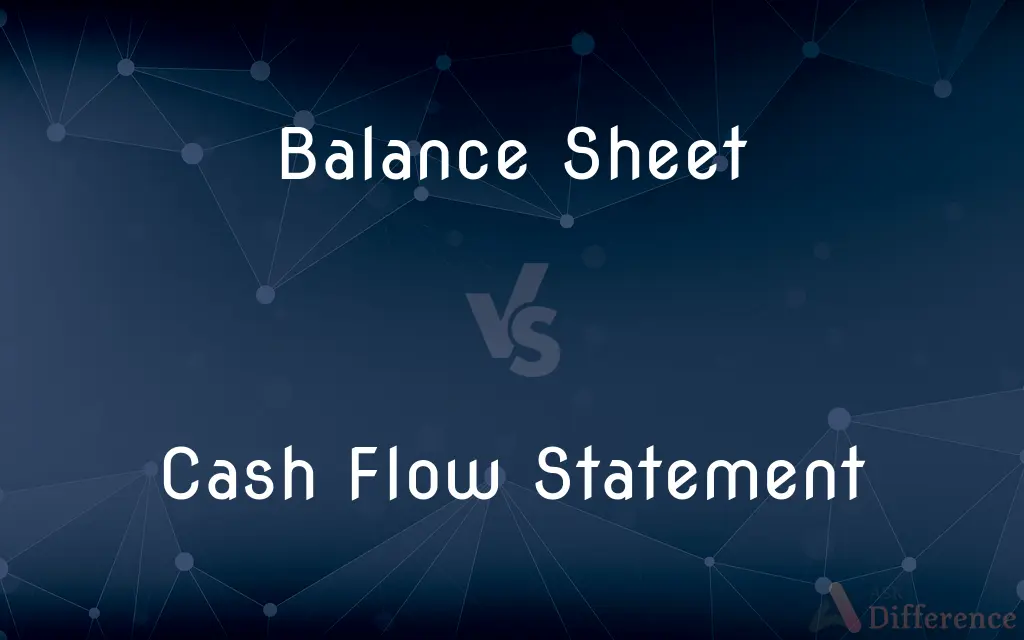Balance Sheet vs. Cash Flow Statement — What's the Difference?
Edited by Tayyaba Rehman — By Fiza Rafique — Published on December 7, 2023
The Balance Sheet provides a snapshot of a company's assets, liabilities, and equity at a specific point in time. The Cash Flow Statement shows how cash moves in and out of a business over a period.

Difference Between Balance Sheet and Cash Flow Statement
Table of Contents
ADVERTISEMENT
Key Differences
The Balance Sheet is one of the primary financial statements that depicts a company's financial position at a particular moment. It presents an organized list of assets, liabilities, and equity. On the other hand, the Cash Flow Statement reveals how a company's cash position changes over a specific period, segregating inflows and outflows into operating, investing, and financing activities.
The Balance Sheet, being a static report, doesn't provide information on how the company arrived at its current financial position. Meanwhile, the Cash Flow Statement, a dynamic report, traces the movement of cash, illustrating how funds were generated and used during the reporting period.
A Balance Sheet helps stakeholders gauge the net worth of a business and its liquidity position. In contrast, the Cash Flow Statement provides insights into a company's capability to generate positive cash flow, manage its operating needs, and make necessary investments.
While both the Balance Sheet and Cash Flow Statement provide invaluable information to investors, creditors, and other stakeholders, they serve different purposes. The Balance Sheet focuses on the company's overall financial health, while the Cash Flow Statement zeroes in on its cash generation and spending patterns.
Despite their differences, the Balance Sheet and Cash Flow Statement are interconnected. For instance, the closing cash balance on the Cash Flow Statement should match the cash and cash equivalents figure on the Balance Sheet.
ADVERTISEMENT
Comparison Chart
Nature
Snapshot at a specific date
Movement over a period
Components
Assets, Liabilities, Equity
Operating, Investing, Financing Activities
Purpose
Reflects financial position
Tracks cash inflows and outflows
Time Frame
Specific point in time
Covers a range of time
Interrelation with other statements
Affected by Income Statement and Cash Flow Statement
Derived from Balance Sheet and Income Statement
Compare with Definitions
Balance Sheet
A snapshot that showcases what a business owns and owes.
The Balance Sheet for the fiscal year-end revealed the company's robust financial position.
Cash Flow Statement
A financial report illustrating the inflows and outflows of cash in a business.
The Cash Flow Statement revealed the company's strong cash generation from its operating activities.
Balance Sheet
A document detailing a firm's financial standing at a certain point.
Lenders often request a Balance Sheet to assess a business's creditworthiness.
Cash Flow Statement
A record indicating a company's liquidity changes over time.
The decline in cash reserves, as shown on the Cash Flow Statement, raised concerns among stakeholders.
Balance Sheet
A statement reflecting the net worth of a business.
Investors scrutinized the Balance Sheet to determine the company's intrinsic value.
Cash Flow Statement
A document detailing how cash moves within a company over a duration.
By analyzing the Cash Flow Statement, the manager identified areas where spending could be reduced.
Balance Sheet
A ledger displaying the equilibrium between a company's resources and obligations.
The Balance Sheet confirmed that the firm had maintained a healthy ratio of assets to liabilities.
Cash Flow Statement
A statement showing the sources and uses of cash in operating, investing, and financing activities.
The Cash Flow Statement highlighted the substantial investment the company made in new machinery.
Balance Sheet
A financial statement presenting a company's assets, liabilities, and equity at a specific date.
After reviewing the Balance Sheet, it was evident that the company had more assets than liabilities.
Cash Flow Statement
A financial tool measuring the cash generation and expenditure of a firm.
The positive numbers on the Cash Flow Statement indicated the company's adeptness at managing its cash flow.
Common Curiosities
How is the Balance Sheet different from the Cash Flow Statement?
The Balance Sheet provides a financial snapshot at a particular date, while the Cash Flow Statement shows cash movements over a period.
Can a company have a positive Cash Flow Statement and a weak Balance Sheet?
Yes, a company might have short-term cash inflows but still have more liabilities than assets on its Balance Sheet.
How does the closing cash balance on the Cash Flow Statement relate to the Balance Sheet?
The closing cash balance on the Cash Flow Statement should align with the cash and cash equivalents figure on the Balance Sheet.
Is it possible for the Cash Flow Statement to indicate large inflows from financing while the Balance Sheet shows high debt?
Yes, if a company borrows heavily or issues new stock, it can have inflows from financing and also high liabilities or equity on the Balance Sheet.
Can a company be profitable but have negative cash flow as per the Cash Flow Statement?
Yes, profitability (from the Income Statement) doesn't always translate to positive cash flow.
Why is equity on the Balance Sheet essential?
Equity on the Balance Sheet represents the ownership value and shows how much would be left for shareholders if assets were sold and liabilities paid.
How do non-cash expenses like depreciation affect the Cash Flow Statement and Balance Sheet?
While depreciation reduces net income on the Income Statement and asset value on the Balance Sheet, it's added back on the Cash Flow Statement since it's a non-cash expense.
What is a Balance Sheet?
A Balance Sheet is a financial statement that shows a company's assets, liabilities, and equity at a specific point in time.
What is the purpose of the Cash Flow Statement?
The Cash Flow Statement tracks how cash enters and leaves a business, segmented into operating, investing, and financing activities.
What does negative cash flow in the operating activities section of the Cash Flow Statement indicate?
It suggests that a company might be facing challenges generating cash from its core business activities.
Share Your Discovery

Previous Comparison
Trigonal Planar vs. Trigonal Pyramidal
Next Comparison
Pet Animals vs. Domestic AnimalsAuthor Spotlight
Written by
Fiza RafiqueFiza Rafique is a skilled content writer at AskDifference.com, where she meticulously refines and enhances written pieces. Drawing from her vast editorial expertise, Fiza ensures clarity, accuracy, and precision in every article. Passionate about language, she continually seeks to elevate the quality of content for readers worldwide.
Edited by
Tayyaba RehmanTayyaba Rehman is a distinguished writer, currently serving as a primary contributor to askdifference.com. As a researcher in semantics and etymology, Tayyaba's passion for the complexity of languages and their distinctions has found a perfect home on the platform. Tayyaba delves into the intricacies of language, distinguishing between commonly confused words and phrases, thereby providing clarity for readers worldwide.
















































